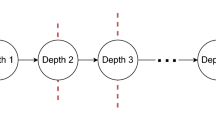Abstract
When the preferences of a decision maker over risky prospects are nonlinear in the probabilities he may display dynamic inconsistency in sequential decisions. In this paper we present the notion of behavioral consistency as a way of modelling individual behavior in situations involving sequential choice of decision makers whose preferences are nonlinear in the probabilities. According to this approach each decision maker is represented by a set of agents, one agent for each decision node. Consistent behavior is the perfect-Nash equilibrium in the game among the agents. We discuss the application of this idea to the analysis of games induced by ascending-bid auctions and by search. Finally, we contrast this approach with an alternative approach which is based on nonconsequentialism.
Access this chapter
Tax calculation will be finalised at checkout
Purchases are for personal use only
Preview
Unable to display preview. Download preview PDF.
Similar content being viewed by others
References
Chew, S.H. (1983) ‘A Generalization of the Quasilinear Mean with Applications to the Measurement of Income Inequality and Decision Theory Resolving the Allais Paradox’, Econometrica, 51, 1061–1092.
Dekel, E. (1986) ‘An Axiomatic Characterization of Preferences under Uncertainty: Weakening the Independence Axiom’, Journal of Economic Theory, 40, 304–318.
Fishburn, P.C. (1983) ‘Transitive Measurable Utility’, Journal of Economic Theory, 31, 298–317.
Gilboa, I. (1987) ‘Expected Utility and Purely Subjective Non-Additive Probabilities; Journal of Mathematical Economics 16, 65–88.
Hammond, P. (1988) ‘Consequentialist Foundations for Expected Utility’, Theory and Decision, forthcoming.
Kahneman, D., and A. Tversky (1979) ‘Prospect Theory: An Analysis of Decision under Risk’, Econometrica, 47, 263–291.
Kami, E. and Z. Safra (1987) ‘Ascending Bid Auctions with Behaviorally Consistent Bidders’, Annals of Operations Research, forthcoming.
Kami, E. and Z. Safra (1988) ‘Behaviorally Consistent Optimal Stopping Rules’, The Foerder Institute for Economic Research, Paper No. 9-88.
MacCrimmon, K., and S. Larsson (1979) ‘Utility Theory: Axioms versus ‘Paradoxes’’, in Expected Utility Hypothesis and the Allais Paradox, M. Allais and O. Hagen (eds.), Dodrochet, Holland: D.Reidel Pub. Co.
Machina, M.J. (1982) ‘Expected Utility’ Analysis without the Independence Axiom’, Econometrica, 50, 277–323.
Machina, M.J. (1988) ‘Dynamic Consistency and Non-Expected Utility Models of Choice under Uncertainty’, Mimeo.
Quiggin, J. (1982) ‘A Theory of Anticipated Utility’, Journal of Economic Behavior and Organization, 3, 324–343.
Schmeidler, D. (1984) ‘Subjective Probability and Expected Utility without Additivity’, CARESS Working Paper No.84-21, University of Pennsylvania.
Selten, R. (1965) ‘Spieltheoretische Behandlung unes Oligopolmodells mit Nachfragetragheit’, Zeitschrift fur die Stratswirsenschaft, 121, 301–324.
Strotz, R.H. (1956) ‘Myopia and Inconsistency in Dynamic Utility Maximization’, Review of Economic Studies, 23, 165–180.
Wakker, P.P. (1988) ‘Nonadditive Probabilities and Derived Strengths of Preferences’, Univeresity of Nijmegen.
Yaari, M.E. (1977) ‘Endogenous Changes in Tastes: A Philosophical Discussion’, Erkentis, 11.
Yaari, M.E. (1987) ‘The Dual Theory of Choice under Risk’, Econometrica, 55, 95–115.
Author information
Authors and Affiliations
Editor information
Editors and Affiliations
Rights and permissions
Copyright information
© 1991 Springer Science+Business Media Dordrecht
About this chapter
Cite this chapter
Karni, E., Safra, Z. (1991). Behavioral Consistency In Sequential Decisions. In: Chikán, A. (eds) Progress in Decision, Utility and Risk Theory. Theory and Decision Library, vol 13. Springer, Dordrecht. https://doi.org/10.1007/978-94-011-3146-9_30
Download citation
DOI: https://doi.org/10.1007/978-94-011-3146-9_30
Publisher Name: Springer, Dordrecht
Print ISBN: 978-94-010-5387-7
Online ISBN: 978-94-011-3146-9
eBook Packages: Springer Book Archive




